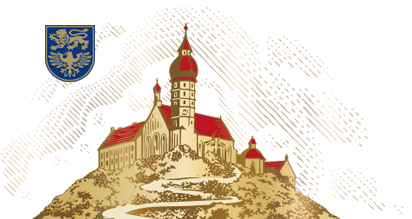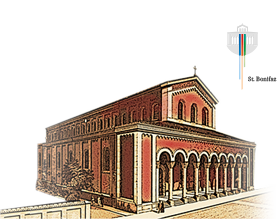Benedict of Nursia
Benedict (around 480-547) was a theological personality who made an impact far beyond his lifetime. As a “seeker of God”, he continues to define the monastic movement to this day.
He left few historic traces. Yet his Rule shaped the faith and culture of an entire continent. The second book of the Dialogues by Pope Gregory the Great (590-604) written around the year 594 is a source of biographical knowledge about Benedict.
Worldly wisdom through always new experiences
It is a sacred work that describes the saint’s healing power and gift of prophecy in pictures. Many of the stories are based on biblical examples. Benedict was born in Nursia (Norcia), a town north-east of Rome, around the year 480. He cut short his studies in Rome and withdrew to the seclusion of Subiaco. Students flocked to him. Gregory describes him as a person “with the heart of an old man even since his childhood”. In the Dialogues, he appears as someone who gains worldly wisdom through always new experiences.
Direction and hope from the Holy Scripture
Around the year 528, he and a small group of this students went to a mountain near Casinum (Montecassino) between Rome and Naples and built a monastery. He reportedly died on 21 March 547. When designating Benedict as the author of his Rule, one cannot assume today’s concept of authorship but has to consider the understanding of literature in the ancient world. The Holy Scripture was the primary source for his Rule. For Benedict, the Scripture was the living word of God, heard anew day after day, from which the God seeker receives direction, strength and hope.
Literature
There is a wealth of literature about the life of Saint Benedict. Here are a few recommendations:
- Grün, Anselm, Benedikt von Nursia. Meister des Maßes – geerdete Spiritualität, Freiburg (Herder) 2017, 176 pages.
- Vollmann-Profe, Gisela (publisher), Gregor der Große. Vita Benedicti. Das Leben und die Wunder des verehrungswürdigen Abtes Benedikt, Latin/German, Ditzingen (Reclam) 2015, 160 pages.
- Herrmann, Bettina, Wittmann, Sybille, Benedikt und der Rabe, Munich (Don Bosco) 2015, 24 pages. [Especially well suited for children aged 3 and up]
- Müller, Christoph, Benedikt für Anfänger. Lebensweisheiten aus dem Kloster, Innsbruck (Tyrolia) 2015, 95 pages.
- Schellenberger, Bernardin, Benedikt von Nursia. Der Werdegang eines spirituellen Meisters – Inspiration für heute, Würzburg (Echter) 2015, 128 pages.
- Abeln, Reinhard, Der heilige Benedikt. Leben – Legenden – Bedeutung, Kevelaer (Topos plus) 2014, 90 pages.
- Grün, Anselm, Benedikt von Nursia. Seine Botschaft heute, Münsterschwarzach (Vier Türme) 2011, 78 pages.
- Guy, Lehideux, Benedikt von Nursia. Bote des Friedens, Straßburg (Sadfia Media) 2011, 52 pages.
- Ernst, Anna, Benedikt von Nursia und seine Botschaft heute. Arbeiten für eine bessere Welt, Cologne (Fackelträger) 2008, 192 pages.
- Puzicha, Michaela, Benedikt von Nursia begegnen, Augsburg (St.-Ulrich-Verlag) 2008, 176 pages.
- Ceserani, Gian P., Auf den Spuren von Benedikt, Stuttgart (Katholisches Bibelwerk) 2006, 32 pages. [Especially well suited for children and adolescents aged 12 and up]




